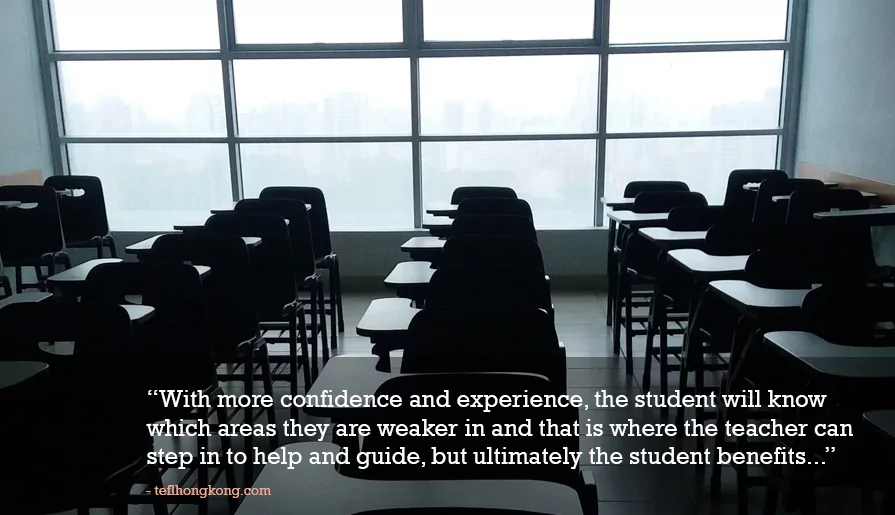
- By: Amy Heath
- In: English Teacher
When you think of a classroom, do you see the typical set up of a teacher at the front with students sitting in separate desks? Well, then that is just one kind of classroom design, while many exist, where the two methods, student-led and teacher-led, gets blended.
Teacher Training Courses:
1. CertTESOL: Certificate in TESOL
A level 5, initial teacher training qualification for new and experienced teachers, equivalent to Cambridge CELTA.
2. CertPT: Certificate for Practising Techers
A level 6, online professional development course for working teachers.
Defining student-led (SL) and teacher-led (TL) approaches
Teacher-led Class: A teacher-led class is designed for the teacher to be the centre of attention to deliver a presentation or lecture to the students. As the teacher will usually need a board, interactive whiteboard, or projector, the students will face the teacher for the lesson.
In the TL method, the students take direction from the teacher, and follow a syllabus that all students have to conform to pass. Though the method is teacher-led, it does allow some interaction with the students, but it differs from a student-led approach both in the methodology, atmosphere, and the layout of the classroom.
Student-led Class: Student-led learning has a different focus that allows for more learner autonomy. Students are not left entirely to their own devices. Instead, they are guided in being independent learners, able to track their development and achieve their own goals.
As the approach is different, so is the set up of the classroom. The students may have desks organised into pods around the classroom, for instance. It is not just the arrangement of the class that is different, but the atmosphere too.
If you walk into a SL class, you might find it noisier and more dynamic than a TL class. The hope for every teacher is that the students enjoy themselves and are motivated to engage with the material and each other. What this could entail is that the students themselves lead discussions and research areas that are relevant for their own development.
Also Read: How can you get your learners speaking more in class?
How do they differ?
As you can see in the definition difference, SL and TL classrooms look different and have their own atmospheres. On one hand, the focus is on the teacher; but on the other hand, the focus is on the students’ own perception of their learning.
SL is not a case of ‘anything goes’, but rather, what the students’ learning needs and goals are, and how we can facilitate this in the classroom. In the SL class, when a student feels they have mastered a particular part of the syllabus, they can move on, or ask for more time on a project if they need it. What this autonomy does is foster a sense of responsibility, which is essential if you want to promote lifelong learning.
That said, many students (and their parents) are more comfortable in a TL class because they are familiar with the routine. The teacher imparts knowledge, students learn, teachers test, students pass, based on how much they know.
Is one better than the other?
Discussions on SL and TL approaches to teaching and learning can get quite heated. It’s not about one being better than the other, but it is more about one being more traditional, while the other is fast becoming the norm in classrooms around the world. People can be resistant to change.
It’s not that the SL approach is a fad, rather it’s far and wide that we find the rise of technology has given us more independence in our learning. We can take courses online and track our own development with the aid of new software.
Teachers can’t stop students from doing their own research online and bringing their findings to the classroom. Allowing students to take more responsibility for their studies can bring long-term benefits with it, not the chaos some parents might think.
Some of these benefits include the love of learning independently, which fosters a sense of confidence. Responsibility for one’s own progress is also a benefit of SL learning. Traditionally, passing exams brought the confidence, but in the SL approach, exams may not carry the pressure they once did when you allow parts of the courses to be assessed via continuous assessment.
In some cases, it is what you study that determines which method you use or if you mix both into your lessons. In ESL, we know that learning a language is a dynamic process and that allowing students to have more freedom can inspire them to develop their skills to the best of their ability. Here teacher is not replaced but is on hand guiding as always.
How to incorporate both methods in your teaching
Building rapport in the classroom can help a teacher to get to know their students better. When the class is a comfortable space to be in, both visually and also in terms of atmosphere, students tend to relax and enjoy the learning process.
The draconian teacher who demands silence and instills fear may bring the best out of students who learn that way, but on the whole, students and teachers who get on well find that learning takes places quite naturally.
If your classroom is set up for more traditional teaching, remember that it’s not just the room design that makes a class more SL oriented. When the teacher allows students to speak up, ask questions and get involved in what they learn and when they learn it, the class automatically becomes more student-led.
To find out what your students want, you can type out a questionnaire about the course and its content asking the students to grade their skills, their confidence, and even give you feedback on what the course has already covered.
With the feedback, you can tailor your lessons to cover the topics they are interested in or practise the skills they feel weaker in. Learning a language should be more student-led as the student develops his or her English language skills, but this does not do away with the teacher.
With more confidence and experience, the student will know which areas they are weaker in and that is where the teacher can step in to help and guide, but ultimately the student benefits by advancing at his/her own pace.
Please Share:This article was originally published on January 13, 2020 and was last updated on December 17, 2020.
Courses We Offer:

1. CertTESOL: Certificate in TESOL
A level 5, initial teacher training qualification for new and experienced teachers, enabling you to teach English anywhere in the world. The course is equivalent to Cambridge CELTA.
Learn More
Developed by our Trinity CertTESOL experts, for a comprehensive, self-paced learning experience. Earn an internationally recognized certificate and master essential teaching skills, accessible globally 24/7.
Learn More